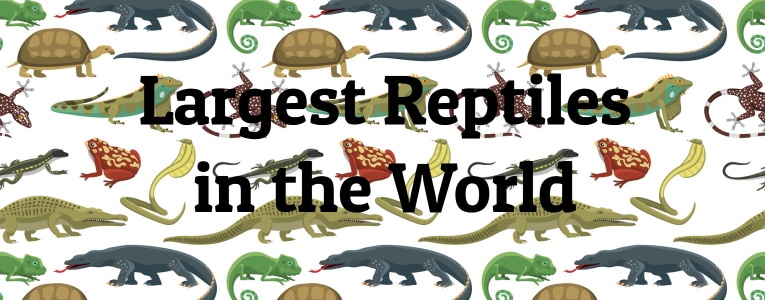When most people think of huge reptiles, their minds immediately jump to dinosaurs–but you’re highly unlikely to come across one of those on your next hiking trip! What are some of the largest reptiles that still roam the Earth and can be encountered today? This list arranges these massive reptiles in order by their mass, though other dimensions such as length can reach impressive numbers as well.
Today we’ll be looking at the 15 largest species of reptiles that live on our planet in the modern era, and learning a little bit about what makes each one stand out. These fascinating species are sure to help you appreciate how large reptiles can actually get!
-
Galápagos Tortoise – (Chelonoidis nigra)
Average Length: 4.9 feet
Diet: Herbivorous
Location: Galápagos Islands
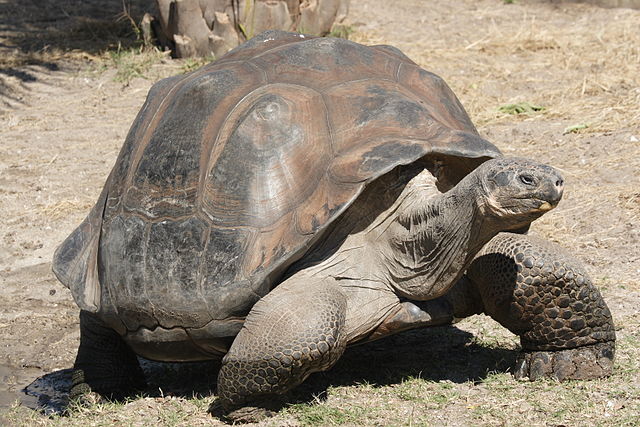
Source: wikimedia.org
The proud-looking Galápagos Tortoise is such an iconic creature that it is actually the namesake for the Galápagos Islands. This large reptile can live to be over 100 years old if left alone–unfortunately, however, habitat destruction and poaching have threatened the tortoise’s numbers.
There are two varieties of Galápagos Tortoises, and the main difference between the two is their shell. Those of the larger variety with rounder shells are called “domes,” while the smaller turtles with shells that curve upwards at the front are called “saddlebacks”. Saddlebacks are often found on the hotter, drier islands of the Galápagos, and stretch their long necks in order to reach edible vegetation.
Did You Know?
The shell of the Galápagos Tortoise may look astoundingly heavy, even for such a large reptile to carry around. However, it’s made up of a honeycomb-like structure that enables it to stay strong while being much less heavy than it looks.
-
Slender-Snouted Crocodile – (Mecistops cataphractus)
Average Length: 10.8 feet
Diet: Carnivorous
Location: Africa

Source: wikimedia.org
This lesser-known Crocodile lives in freshwater habitats primarily in Central Africa. The Slender-Snouted Crocodile frequents the shores of rivers and lakes in tropical rainforest areas, but is sometimes found in savannah areas as well. This impressive reptile, as its name would suggest, is characterized by its long and slender snout, which lines up with its eyes and ears on the top of its head. This enables the Slender-Snouted Crocodile to float stealthily just beneath the surface of the water, hidden from prey but still able to see, hear, and breathe. Additionally, this predator’s dark olive and blotchy skin color allow it to wait unseen and undisturbed in the water.
Did You Know?
The Slender-Snouted Crocodile feeds primarily on fish. It swims parallel to the edges of rivers and lakes, using its long tail to trap its prey against the edge of the water for easy consumption.
-
Green Sea Turtle – (Chelonia mydas)
Average Length: 3.7 feet
Diet: Primarily Herbivorous
Location: Tropical and subtropical coastal waters worldwide
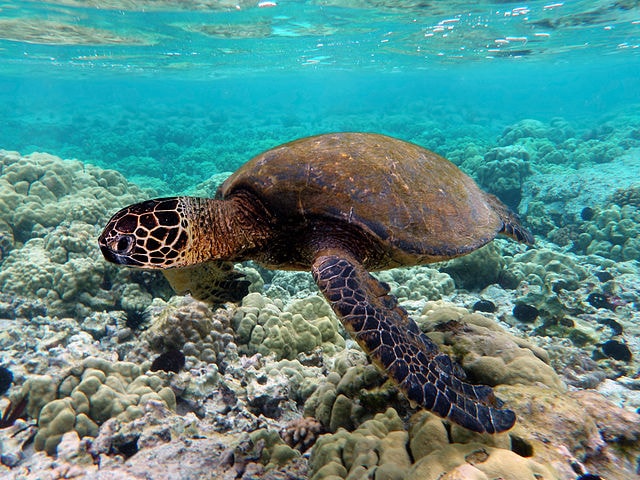
Source: wikimedia.org
Despite being named the Green Sea Turtle, this large reptile does not always have a green shell. This turtle’s green-tinted skin is more likely the inspiration for its name, while its shell can come in a variety of olive and brown shades. The tint of a Green Sea Turtle’s shell actually varies according to its habitat, ensuring that it will have the best possible chances at blending in. Green Sea Turtles spend nearly all of their time in the water once they hatch and make it to the sea, having no reason to beach unless it’s time to breed and nest. While female turtles only breed every 3-4 years, males can come back to mate every single year.
Did You Know?
Healthy Green Sea Turtles enjoy long life spans of up to 80-100 years.
-
Loggerhead Sea Turtle – (Caretta caretta)
Average Length: 3.2 feet
Diet: Primarily Carnivorous
Location: Subtropical and tropical regions of the Atlantic, Pacific, and Indian Oceans

Source: wikimedia.org
The beautiful Loggerhead Sea Turtle is a wide-ranging species, and can be found in subtropical and tropical waters all around the globe. These turtles migrate vast distances between feeding grounds and nesting beaches, traveling hundreds of miles out to sea. Female Loggerhead Sea Turtles return to the beaches where they hatched to lay their own eggs, sometimes crossing thousands of miles of ocean to get there. Adult Loggerheads primarily feed on mollusks and crustaceans, easily crushing the hard exoskeletons with their powerful jaws and sharp beaks. Jellyfish, sargassum algae, and other soft foods are sometimes also included in the turtle’s diet.
Did You Know?
The Loggerhead Sea Turtle gets its name from the way its sturdy, oversized head vaguely resembles a log.
-
Aldabra Giant Tortoise – (Aldabrachelys gigantea)
Average Length: 4.6 feet
Diet: Omnivorous
Location: The Aldabra Island in the Indian Ocean
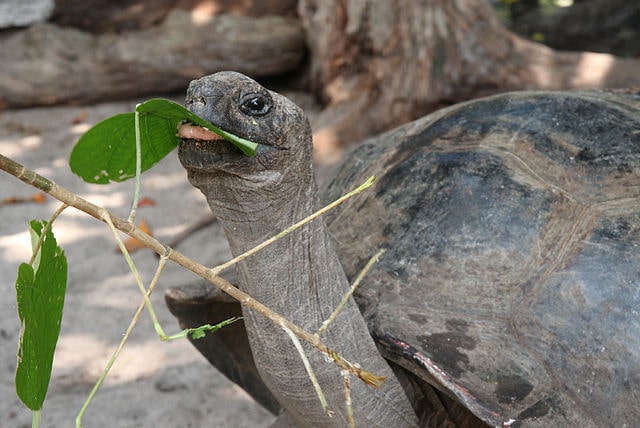
Source: wikimedia.org
This majestic giant tortoise is found almost exclusively on Aldabra Island, one of the Seychelles islands north of Madagascar. It has been introduced to the Mauritius and Reunion Islands as well. It largely frequents the coral atoll around Aldabra Island, and is the largest animal to live on the atoll. Other habitats of the Aldabra Giant Tortoise include mangrove swamps, grasslands, and coastal dunes. This sizeable reptile generally prefers to feed on vegetation, but will adapt its diet as needed to include small invertebrates and occasionally carrion. The Aldabra Giant Tortoise utilizes its long neck to reach edible vegetation as high as three feet off the ground.
Did You Know?
While almost completely uninterested in humans, these giant reptiles have been known to spend time in groups of their own species. They are most active early in the morning, preferring to eat and socialize before it gets too hot.
-
Malayan Gharial (False Gharial) – (Tomistoma schlegelii)
Average Length: 13.3 feet
Diet: Carnivorous
Location: Southeast Asia
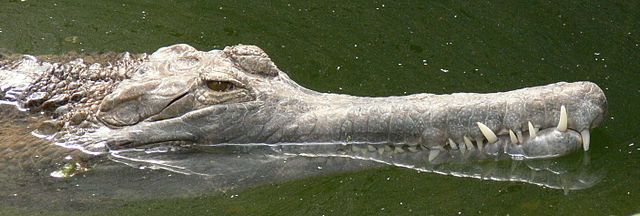
Source: wikimedia.org
Possessing genetic traits of both crocodiles and gharials and therefore a challenge to classify by family, the Malayan Gharial remains somewhat of an enigma. It was formerly named the “False Gharial” because of this biological grey area, and certainly possesses some unique traits. This fascinating reptile sports the signature long, narrow snout of the Gharial. Its armored skin is dark brown on its back, creamy yellow on its belly, and banded on the tail. Its eyes and nose are both conveniently positioned on the top of its head, enabling it to see and breathe while almost entirely submerged.
Did You Know?
The Malayan Gharial is a freshwater reptile, and is native to six river systems in Sumatra and Malaysia. Fossils of this species have been found in southern China, indicating that it used to inhabit a much broader area than it does today.
-
Mugger Crocodile (Marsh Crocodile) – (Crocodylus palustris)
Average Length: 9 – 13 feet
Diet: Carnivorous
Location: Middle East and India
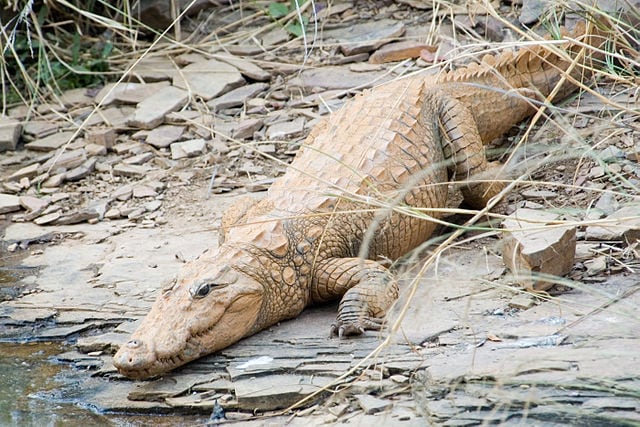
Source: wikimedia.org
This lengthy reptile primarily inhabits the freshwater areas of the Indian subcontinent, but is adapted to be able to sustain in saltier waters such as those of coastal lagoons. The Mugger Crocodile population dwindled to alarmingly low numbers, but the government of Nepal has taken measures to both preserve and improve the crocodiles’ habitat. Prevention of poaching and encroachment upon the animals’ habitat are the prime focus. Marsh Crocodiles are recognized as being an important part of the local ecosystem that does its part to help the habitat thrive properly.
Did You Know?
The casual Indian name “Mugger Crocodile” is derived from the Hindi word “magar” which means “water monster”.
-
American Alligator – (Alligator mississippiensis)
Average Length: 9 – 13 feet
Diet: Carnivorous
Location: North America
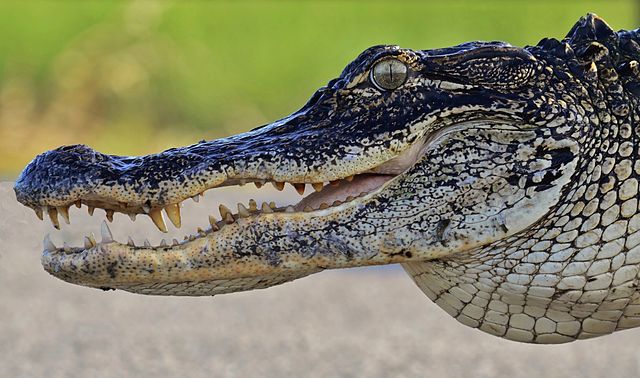
Source: wikimedia.org
This massive species is estimated to be over 150 million years old, and is thought to have lived alongside the dinosaurs and survived the meteor that killed them off. The American Alligator now lives almost exclusively in the southeastern United States, primarily inhabiting bodies of freshwater in Louisiana and Florida. It is considered to be the largest reptile in the United States, and can look concerningly similar to logs when floating in the water. This is attributed to the distinct, dark scutes on its back and its tendency to wait stealthily in the water for prey to approach while hunting.
Did You Know?
While the American Alligator population is densest in Florida and Louisiana, they sporadically inhabit freshwater areas all the way from North Carolina to the Rio Grande in Texas.
-
Gharial (Gavial) – (Scientific)
Average Length: 11 – 17 feet
Diet: Carnivorous
Location: India
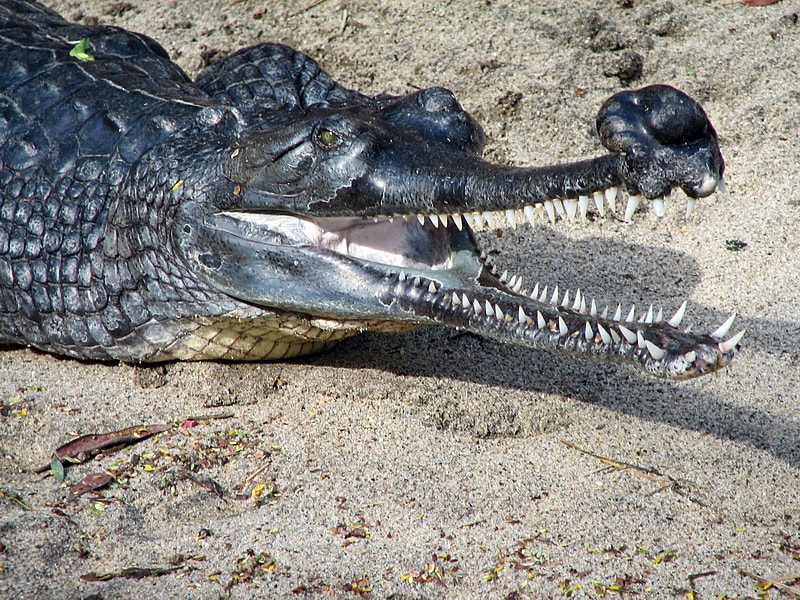
Source: wikimedia.org
The Gharial, or Gavial, stands apart from similar varieties of crocodiles as a result of the bulbous growth at the end of the male’s snout. Females are easily distinguished by their similarly long, slender snouts. The bulbous tip of the male Gharial’s snout is called a “ghara,” which is the Hindi word for “pot”. This namesake bump is used to blow bubbles and create impressive sounds during mating displays. Gharials are actually the only crocodile with such visually distinct sexual dimorphism, or differences between male and female members of their species.
Did You Know?
Gharials do not use stealth to hunt like most other crocodilians do. Their unique snouts contain sensory cells that help them pick up vibrations of other life in the water. Once prey comes within range, Gharials whip their heads to the side and snatch it out of the water.
-
-
American Crocodile – (Crocodylus acutus)
-
Average Length: 10 – 14 feet
Diet: Carnivorous
Location: North, Central, and South America
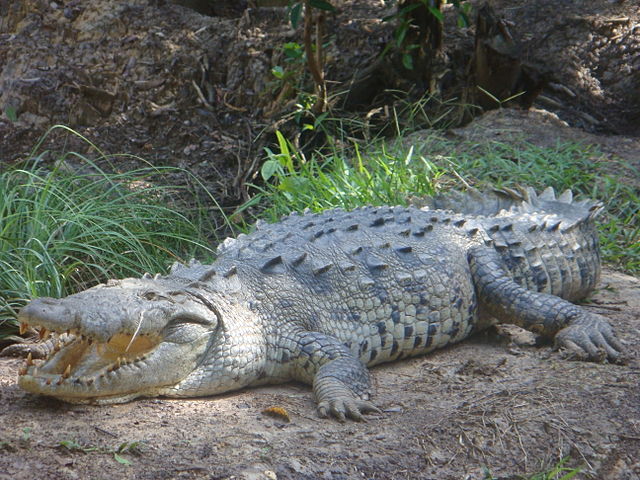
Source: wikimedia.org
This American giant, while often mistaken for the American Alligator, is a distinctly different reptile. It can be differentiated by its comparatively thinner snout, lighter color, and bottom teeth that are visible when its mouth is closed. The American Crocodile’s intimidating appearance is further enhanced by its grey or olive green skin, which is tough and covered in scaly armor. South Florida is the only location where both the American Crocodile and American Alligator coexist and can be compared to one another in the wild.
Did You Know?
Unlike some other crocodilians, the American Crocodile is relatively shy. It often lies still on the shore, basking in the sun, and will usually scramble into the water to avoid confrontation if startled.
-
Black Caiman – (Melanosuchus niger)
Average Length: 9 – 14 feet
Diet: Carnivorous
Location: South America
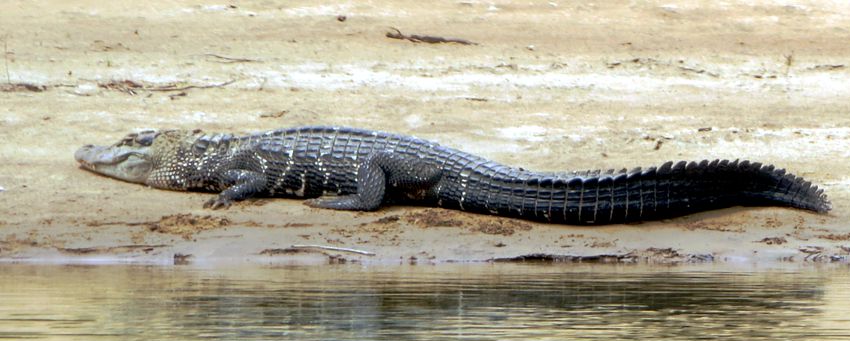
Source: wikimedia.org
The impressive Black Caiman owes its name to its strikingly dark exterior, which helps it camouflage itself during nocturnal hunting sessions and more effectively warm itself in the sun. These massive reptiles also usually have white or light yellow spots adorning its size, and distinct bands across the jaws–however, these markings become less distinct as the Black Caiman ages. This predator rules over its freshwater habitat as the largest member of the family “Alligatoridae” and the largest known predator in the Amazon Basin.
Did You Know?
The Black Caiman is considered an apex predator, and can take down and eat just about any animal that crosses its path. It possesses enough force behind its bite to puncture turtle shells, and boasts enough strength to drown large prey animals underwater.
-
Leatherback Sea Turtle – (Dermochelys coriacea)
Average Length: 6.6 feet
Diet: Carnivorous
Location: Tropical and temperate oceans
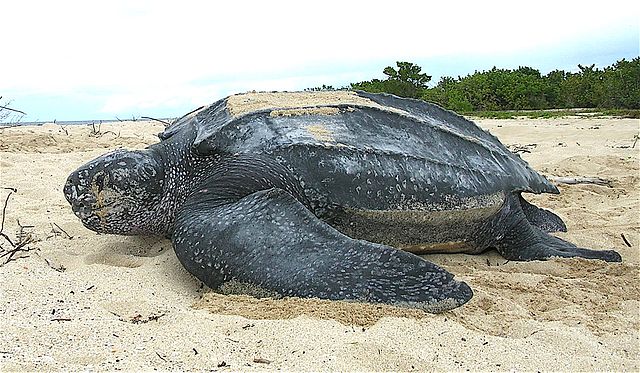
Source: wikimedia.org
The largest turtle in the world, the Leatherback Sea Turtle gets its name from its unusually soft outer shell. While most turtles have a hard, rigid shell covering their backs and stomachs, this hulking species instead has a leathery exterior with ridges that help streamline it while swimming and diving to extreme depths.
Leatherback Sea Turtles also utilize adaptations such as their size and a layer of insulating fat to expand their habitat range to colder waters than most reptiles can tolerate. This impressive sea turtle uses its delicate mouth to survive off a diet of jellyfish and other soft-bodied creatures. The Leatherback’s throat is lined with small, downward-curving spines known as papillae, which make it easier to swallow its prey.
Did You Know?
The Leatherback Sea Turtle is the only living member of the family Dermochelyidea, and the oldest known species of sea turtle.
-
Orinoco Crocodile – (Crocodylus intermedius)
Average Length: 12 – 16 feet
Diet: Carnivorous
Location: South America
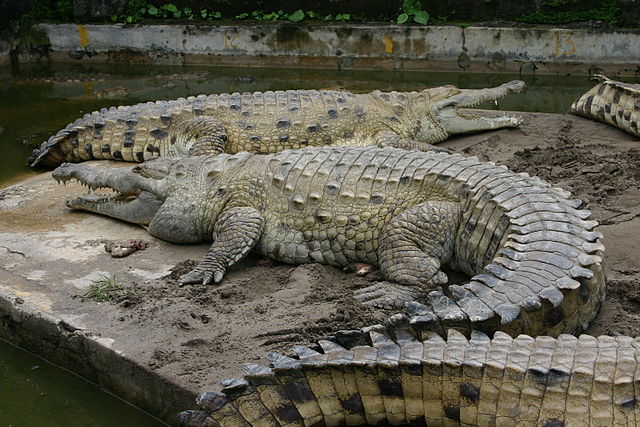
Source: wikimedia.org
This critically endangered crocodile’s habitat is almost entirely restricted to the Orinoco Basin in Colombia and Venezuela. The Orinoco Crocodile is the largest predator in South America by mass, as well as the rarest, and comes in an interesting set of colors. These crocodiles are often pale green or yellow in color, and sport a smattering of dark spots that help with camouflage. Orinoco Crocodiles retain the unique ability to shift their color over time, as the melanin levels in their skin change with age.
Did You Know?
Orinoco Crocodiles used to be far higher in population, until their eye-catching skins became a highly desirable trade resource for Venezuelan hunters. Excessive hunting reduced the population to alarmingly low numbers, and conservation efforts that include breeding programs have been put in place to save the species.
-
Nile Crocodile – (Crocodylus niloticus)
Average Length: 12 – 18 feet
Diet: Carnivorous
Location: Africa and Madagascar
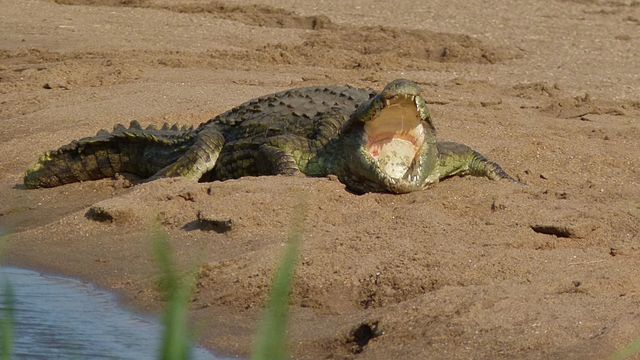
Source: wikimedia.org
This giant reptile is considered to the the largest freshwater predator in Africa, as well as the most common. A strange myth once claimed that these crocodiles need to allow their prey to begin decomposing before they can tear away the meat and eat their meal. However, this is certainly untrue–while the dominant Nile Crocodiles in their area might eat at a leisurely pace and occasionally scavenge carrion, they consistently avoid eating meat that has already begun decomposing. This massive hunter’s diet usually consists of fish, but it has nothing against eating birds, small hippos, and other crocodiles.
Did You Know?
The Nile Crocodile has webbed hind feet, and utilizes a handy valve in its throat that allows it to grasp and submerge its prey without taking water into its esophagus.
-
Saltwater Crocodile (Estuarine Crocodile) – (Crocodylus porosus)
Average Length: 12 – 18 feet
Diet: Carnivorous
Location: Eastern India, Southeast Asia and Northern Australia
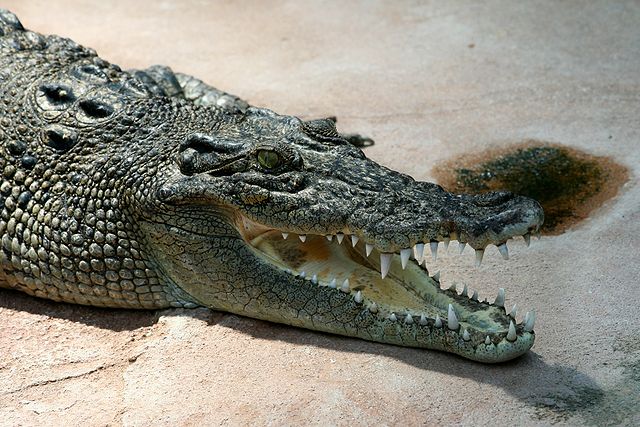
Source: wikimedia.org
The Saltwater Crocodile is the largest reptile in the world today. Its ability to inhabit brackish water enables it to inhabit a wide range of coastal areas, where it often rests just below the surface of the water. This stealthy hunter lies in wait for prey animals to come to the edge of the water for a drink, and then strikes with its powerful jaws, dragging the creature underwater until it drowns. While intimidating, most crocodilians usually avoid interaction with humans rather than confronting them. However, Saltwater Crocodiles have a menacing reputation for being unusually aggressive towards people.
Did You Know?
Female Saltwater Crocodiles lay clutches of around 50 eggs, and watch over them carefully until they hatch. They also protectively carry their young with them for the first few months of their lives.
